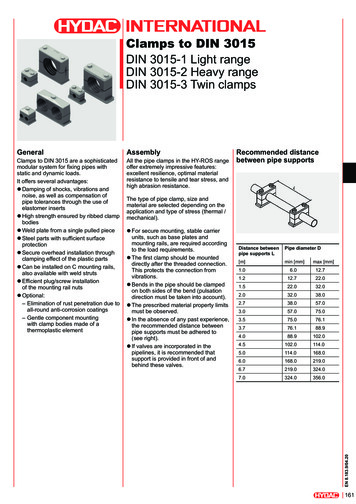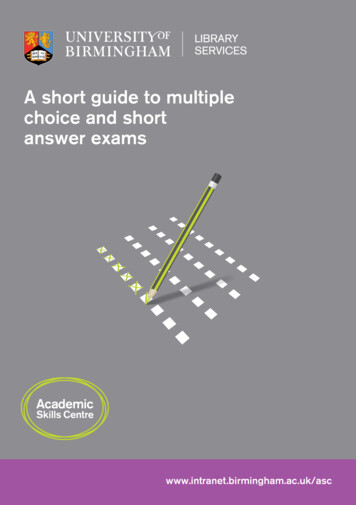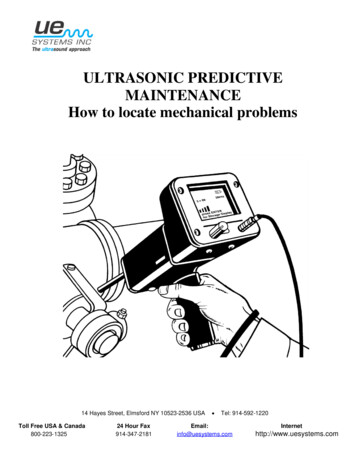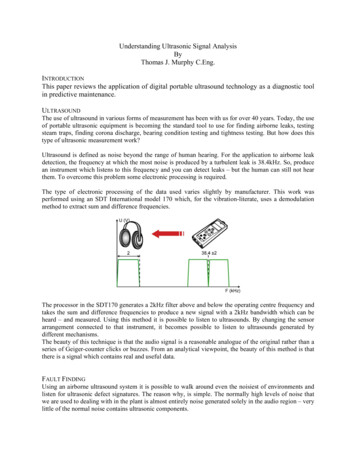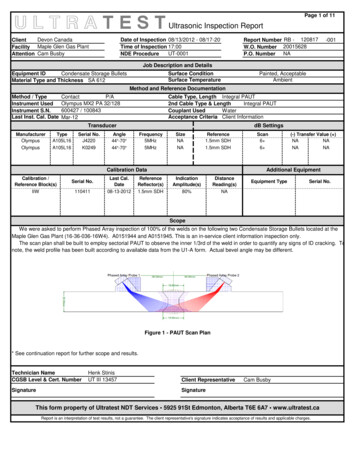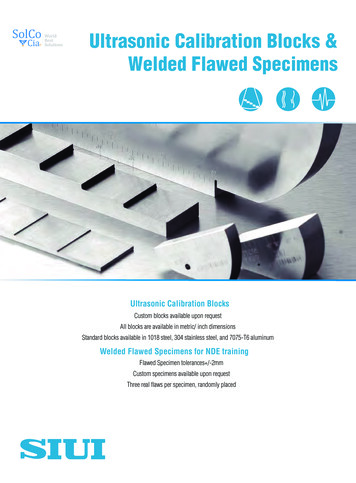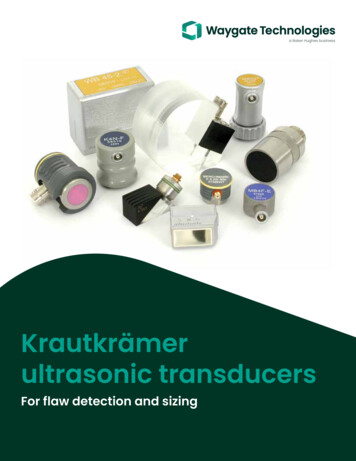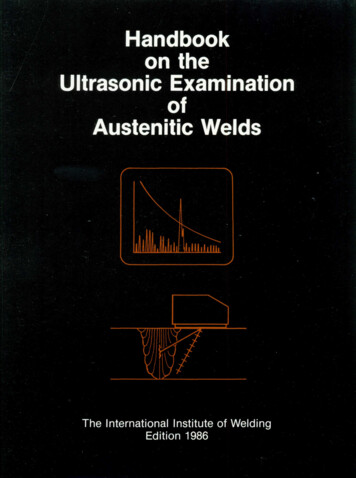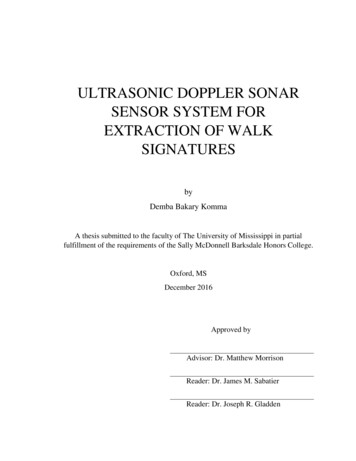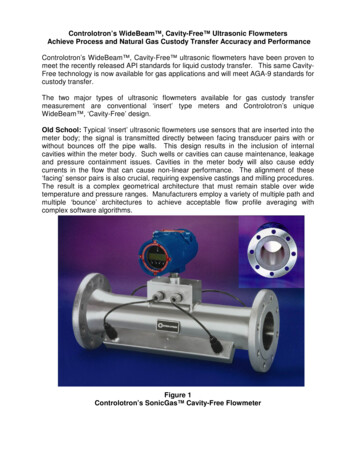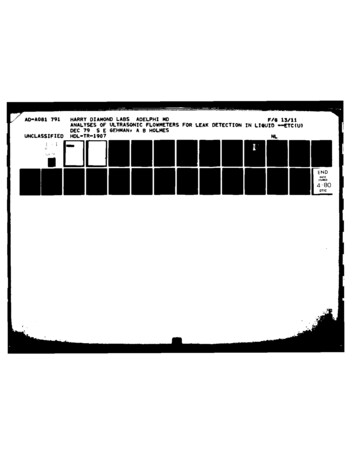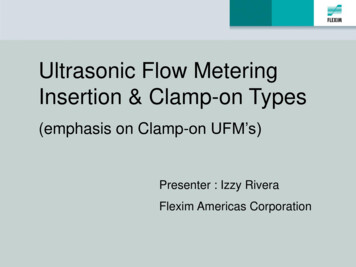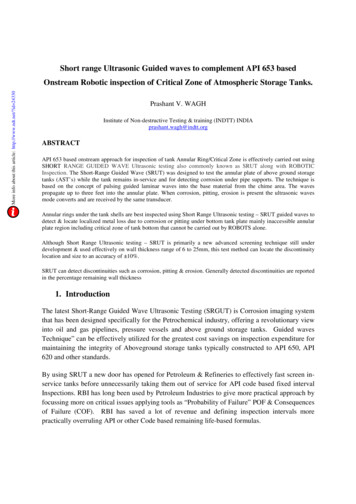
Transcription
Short range Ultrasonic Guided waves to complement API 653 basedMore info about this article: http://www.ndt.net/?id 24330Onstream Robotic inspection of Critical Zone of Atmospheric Storage Tanks.Prashant V. WAGHInstitute of Non-destructive Testing & training (INDTT) INDIAprashant.wagh@indtt.orgABSTRACTAPI 653 based onstream approach for inspection of tank Annular Ring/Critical Zone is effectively carried out usingSHORT RANGE GUIDED WAVE Ultrasonic testing also commonly known as SRUT along with ROBOTICInspection. The Short-Range Guided Wave (SRUT) was designed to test the annular plate of above ground storagetanks (AST’s) while the tank remains in-service and for detecting corrosion under pipe supports. The technique isbased on the concept of pulsing guided laminar waves into the base material from the chime area. The wavespropagate up to three feet into the annular plate. When corrosion, pitting, erosion is present the ultrasonic wavesmode converts and are received by the same transducer.Annular rings under the tank shells are best inspected using Short Range Ultrasonic testing – SRUT guided waves todetect & locate localized metal loss due to corrosion or pitting under bottom tank plate mainly inaccessible annularplate region including critical zone of tank bottom that cannot be carried out by ROBOTS alone.Although Short Range Ultrasonic testing – SRUT is primarily a new advanced screening technique still underdevelopment & used effectively on wall thickness range of 6 to 25mm, this test method can locate the discontinuitylocation and size to an accuracy of 10%.SRUT can detect discontinuities such as corrosion, pitting & erosion. Generally detected discontinuities are reportedin the percentage remaining wall thickness1. IntroductionThe latest Short-Range Guided Wave Ultrasonic Testing (SRGUT) is Corrosion imaging systemthat has been designed specifically for the Petrochemical industry, offering a revolutionary viewinto oil and gas pipelines, pressure vessels and above ground storage tanks. Guided wavesTechnique” can be effectively utilized for the greatest cost savings on inspection expenditure formaintaining the integrity of Aboveground storage tanks typically constructed to API 650, API620 and other standards.By using SRUT a new door has opened for Petroleum & Refineries to effectively fast screen inservice tanks before unnecessarily taking them out of service for API code based fixed intervalInspections. RBI has long been used by Petroleum Industries to give more practical approach byfocussing more on critical issues applying tools as “Probability of Failure” POF & Consequencesof Failure (COF). RBI has saved a lot of revenue and defining inspection intervals morepractically overruling API or other Code based remaining life-based formulas.
On the other hand, this novel and most easily adaptable technology have enabled fast screeningof tanks before a costly decision is made whether to stop the unit and take a tank out of servicefor detailed international Inspection.Hence for every owner-users of storage tanks, this is truly the most inexpensive and yet highlyaccurate onstream tank inspection technique to adopt without having to enter the tank therebycutting down huge expenditure.SRUT typically targets on highly stressed Critical Zone and beyond up to as much as 1 meter.inwards while the product is inside the tank and tank is in Service. Robotic Inspection does helpsimilar way but not a standalone technique and highly expensive.In this paper, we will demonstrate the work carried out successfully in the world’s leadinginternational Refineries as ARAMCO & SABIC in Saudi Arabia and that this new technology isnow being used for all tanks before deciding on costly Internal Inspections.2. What is different this new technology has to offer?Cost savings associated with using Guided Wave Ultrasonic techniques prior to internalinspections may include lower total inspection costs, lower turnaround costs, avoiding lostproduction opportunities, and avoiding vessel cleaning and decontamination costs. SRUT alsoavoids the safety hazards associated with confined space entry of vessels. An internal inspectionrequires tank to be taken out of service and cleaned, purged, gas tested.NDE inspections as MFL, Ultrasonics, Leak Tests, Vacuum BOX Eddy current, Magnetic &Penetrant need physical access inside the tank.SRUT on the other hand is an onstream Inspection technique capable of detecting both internaland external corrosion on Tank bottom which the most important area to be inspected forintegrity of tank.3. Necessity of periodic inspections in Refinaries .Inspection and maintenance are essential. There's no exception to this rule. Financial impact dueto damage and production interruption could be substantial. Contents of the tank, weather oroperating conditions can lead to leakages. Localized corrosion & deterioration can causeproblems. To maintain the tanks intact and to take the right maintenance action at the right timerequires in-depth expertise and accurate information from regular Inspections based oninspection Codes.
4. Tank Inspection RegulationsStorage tanks containing organic liquids, non-organic liquids, vapours and can be found inmany industries. Atmospheric storage tanks are designed and built to the AmericanPetroleum Institute code or other construction standards. Atmospheric storage tanks are usedfor storing crude oil, heavy oil, gas oils, furnace oils, naphtha, gasoline, non-volatilechemicals, etc. Low pressure storage tank on the other hand are used for storing light crudeoil, light naphtha, pentane, some volatile chemicals, liquid oxygen, liquid nitrogen.The construction code for the atmospheric storage tank is API STD 650, and for a lowpressure storage tank is API STD 620. These cover the minimum requirements for design,materials, fabrication, inspection and testing. The inspection and test plan (ITP) for storagetank construction needs to meet the requirements of either API STD 650 or API 620. The InService Inspection code for atmospheric storage tank is API STD 653.It is necessary for youto use this standard with the API Recommended Practice 575, which is titled “Guidelines andMethods for Inspection of Existing Atmospheric and Low-pressure Storage Tanks.”API STD 653 addresses only the atmospheric storage tank, but API RP 575 covers bothatmospheric and low-pressure storage tanks.5. Basic Tank InspectionsFollowing inspections are being carried out at definite frequency as per applicable inspectioncodes, RBI or Jurisdictional requirements.5.1 External InspectionAll tanks shall be given a visual external inspection by an authorized inspector. Thisinspection must be conducted at least every five years or RCA/4N years (RCA is thedifference between the measured shell thickness and the minimum required thickness in mils,and N is the shell corrosion rate in mils per year) whichever is less5.2 Internal inspectionA certified API inspector, along with an ASNT-certified examiner, must perform thisinspection before the end of the corrosion life of the bottom of the tank or twenty years,whichever is less. If no corrosion rate is available, then they must perform the full inspectionwithin ten years. An internal inspection may include a comprehensive visual inspection of theentire tank interior, ultrasonic-thickness testing of the bottom plates, magnetic-flux-leakagetesting of the bottom plates, Vacuum-box testing of the bottom and shell-to-bottom weldseams, settlement surveys and, in some cases, fluorescent-magnetic-particle testing of theshell-to-bottom weld seam. Internal inspection is primarily to ensure that the bottom is notseverely corroded and leaking & to identify and evaluate any tank bottom settlement.
5.3 Risk based inspection5.3.1 RBI to determine inspection intervals and type & extent of inspection.When an owner user chooses to conduct RBI assessment it must include systematic evaluation ofboth probability of failure & consequences of failure in accordance with API 580, API 581.Identifying & evaluating potential damage mechanisms, current equipment condition &effectiveness of past inspection are important steps in assessing probability of pressure vesselfailure. Identifying & evaluating process fluids, potential injuries, environmental damage &equipment down time are important steps in assessing consequence of pressure vessel failure.5.3.2 Probability assessmentProbably of assessment should be based on all kinds of damage that could be reasonablyexpected to affect a Tank or Vessel in a service. Includes internal/external metal loss fromlocalized general corrosion, all forms of cracking, other forms of metallurgical, corrosion &mechanical damage (fatigue embrittlement, creep) effectiveness of inspection tools & techniquesin finding potential damage mechanisms. Additionally, the effectiveness of the inspectionpractices, tools, and techniques for finding the potential damage mechanisms must be evaluated.5.3.4 Consequence assessmentThe consequence of a release is dependent on type and amount of process fluid contained in theequipment. The consequence assessment should be in accordance with API 580, Section 10 andmust consider the potential incidents that may occur as a result of fluid release, the size of apotential release, and the type of a potential release, (includes explosion, fire, or toxic exposure.)The assessment should also determine the potential incidents that may occur as a result of fluidrelease, which may include health effects, environmental damage, equipment damage, andequipment downtime.5.4 Cathodic protection SurveyWhere exterior tank bottom corrosion is controlled by a cathodic protection system, periodicsurveys be conducted as per API 651. Owner/operator shall review the survey results & shallassure competency of personnel performing surveys.5.4.1Tank Bottom Inspection is most critical for above ground Storage tanks.As per API 653 If the minimum bottom thicknesses, at the end of the in-service period ofoperation, are calculated to be less than the minimum bottom renewal thicknesses in API 653
Table 4.4, or minimum acceptable risk determined by RBI assessment the bottom shall belined, repaired, replaced, or the interval to the next internal inspection shortened.Due to strength requirements, the minimum thickness for tanks in service with product specificgravity less than 1 requiring annular plates (other than seismic loading ), minimum thickness ofannular plates is as per API 653 Table 4.5, plus any CA. as shown above.5 API 653 based latest onstream InspectionsThese methods can be used, under the right circumstances, to supplement or in lieu of invasiveand turnaround inspections, usually at much lower cost. Cost savings associated with using OSItechniques in lieu of internal inspections may include lower total inspection costs, lowerturnaround costs, avoiding lost production opportunities, and avoiding vessel cleaning anddecontamination costs. On-stream inspection also avoids the safety hazards associated withconfined space entry of vessels.7.1 These are API 653 based Robotics Inspection & Short-Range Guided Wave (SRUT)8.1.2 Robotic InspectionRobotic in-service tank bottom inspection allows for inspection according to the API 653standards while tank remains service.This independent tank bottom inspection device uses UT sensors to detect any variations in tankbottom thickness. The scan provides with an API certified inspection of tank bottom.The inspection utilizes a remotely controlled hydraulic robot specifically designed to inspect inservice tank floor bottoms. The robotic navigation system is equipped with robot and navigationtransducers. The robot follows a predetermined digital inspection grid and collects up to amillion ultrasonic scans of the tank bottom to perform computerized data analysis. By using theRobotic Tank Inspection, the tank bottom inspection takes significantly less time & is safer andreliable.
Figure. 1 Remote Robotic Inspection of Tank using hydraulic Robot9.Latest development of Short-Range Guided Wave Inspection ( SRUT).The latest most valuable technique developed for fast accurate 3D mapping of tank internalcondition from outside is Short Range Guided wave called SRUT.The special SRUT probe is placed away from the area of interest (generally concealed surface) toscan up to 1m of material length without losing adequate sensitivity and adaptable to wallthickness range of 6 to 25mm. This test method can locate the discontinuity and size & candetect discontinuities such as corrosion, pitting & erosion. Generally detected discontinuities arereported in the percentage remaining wall thickness and categorized into various severity level.Short Range Ultrasonic testing (SRUT) probes uses multiple frequencies and thus it can identifyall indication providing the efficient generation of the guided wave in the plates. The linear andnewly designed matrix array probes allow optimizing of the guided wave excitation in thematerial with ability of 3D control of the ultrasonic beam.Figure 2 A-Scan CB-Scan Scan presentation of Tank Annular plate condition
SRUT inspection provides the highest degree of signal optimization capturing of the CB-Scanimage of the cut off sample taken out of the annular ring & the sample contains the real corrosiondamages and artificial defects. (See Fig. 2)9.1 Important advantages of this latest advancement are as below. Rapid detection of corrosion & erosion including sizing in accessible areas annular rings.More Accurate than LGUT.Defects detected with a dimensional accuracy within 0.040” for both length & width.High speed corrosion screening.Incremented scans for flaw location.Can inspect thin & thick materials.Light weight portable & be used on Alloys, compositesAllows for rapid scanning of annular rings, under support & hard to access locations100% of surface area (up to 2m length) can be scanned with single inspection scan9.3 How short-range
As per API 653 If the minimum bottom thicknesses, at the end of the in-service period of operation, are calculated to be less than the minimum bottom renewal thicknesses in API 653 . Table 4.4, or minimum acceptable risk determined by RBI assessment the bottom shall be lined, repaired, replaced, or the interval to the next internal inspection shortened. Due to strength requirements, the .
